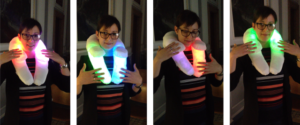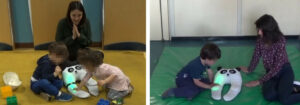Project overview
The project PlusMe: Transitional Wearable Companions for the therapy of children with Autism Spectrum Disorders aims at further developing the +me device and the related experimentation and research involving human participants.
+me: a Transitional Wearable Companion
+me is an experimental, soft, interactive toy looking as a panda that can be worn by a child on his/her neck. Form and materials are designed to arise emotional attachment in its users while reassuring and soothing them, as typically done by transitional objects. These are objects that can be carried with oneself and, as they are always the same, reliable, and enveloping, they can furnish a psychological support, similarly to a “piece of familiar environment” carried with oneself, to children who have difficulties in facing new situations, in particular social situations (think about the “Linus’ blanket”).
At the same time, +me is also an interactive device, endowed with sensors, actuators, that can allow it to actively interact and support the owner. Having these features, we have defined +me as a new class of transitional objects, namely the Transitional Wearable Companions (TWC).
On left, the App controlling the device; on right +me responding to touch.
+me was developed at ISTC-CNR, in collaboration with developmental therapists. Thanks to an Arduino-based embedded electronics, it can emit attractive responses as coloured lights and amusing sounds when touched on paws. Such stimuli are called rewarding outcomes, as children generally show enjoyment when they receive this type of feedback. Moreover, the device is connected to a control tablet which allows an adult caregiver (e.g. a therapist) to modify the input-output contingencies, so as to produce several rewarding response patterns, according to child’s reaction. In other words, +me was designed as an interactive toy capable to produce several different behaviors, with the purpose of stimulating children's curiosity.
Since the control of +me is shared between the child, who handles the panda, and an adult, who selects the different sensory patterns, this allows - at least in principle - to set up several social play activities where the child has to cooperate with the adult to obtain a desired outcome.
All these features make +me a potential support tool for therapy of children with Neurodevelopmental Disorders (ND), with particular reference to Autism Spectrum Disorders (ASD): the attractiveness and the functional versatility of the device could be exploited during play activities with a therapist to capture the interest of children, to encourage their social interactions, then reinforcing pivotal social skills as imitation, eye-contact, turn-taking.

+me can produce several light patterns.
Previous and current experimentation
Since 2018, +me device has been tested in two pilot experiments involving both Typical Developed (TD) children, and children diagnosed with Neurodevelopmental Disorders (ND) as Autism Spectrum Disorders (ASD) and Communication Disorder (CD), aged between 24 and 48 months. Participant with ND have been selected and tested at the Department of Human Neuroscience, Section of Child and Adolescent Neuropsychiatry (University of Rome Sapienza), which supports the experimental phase of this research (click here for further information). These experiments are described in the following open-access papers:
- Acceptability of the Transitional Wearable Companion "+me" in Typical Children : a Pilot Study (2019)
- Acceptability of the Transitional Wearable Companion "+me" in Children with Autism Spectrum Disorders: a Comparative Pilot Study (2020)

Children playing with +me and the researcher, during the pilot experiments.
Project purpose
As the +me prototype is being used in research studies since 2018, the project aims to further develop the device, through 2 main tasks:
- to engineer the current prototype.
The purpose of this task is to improve all the technical aspects of the device (hardware and software), so to make the current prototype closer to a ready-for sale product. - to continue the research.
The purpose of this task is to continue trials involving human participants, and broaden the experimentation to other research centres, laboratories, therapy institutes interested in the use of new technologies applied to the therapy of Autism Spectrum Disorders and other Neurodevelopmental Disorders, characterised by impairments in the social area;
+me: an outcome of the EU project GOAL-Robots
+me device was conceived and developed within the H2020 European project GOAL-Robots: Goal-based Open-ended Autonomous Learning Robots, a research investigating the importance of Intrinsic Motivations (IMs) in the cognitive development of both human and artificial agents (further information on the relationship between the project and the device are available here). In brief, IMs are mechanisms related to the interest for novel objects, surprising events, and success for achieving desired outcomes that trigger behaviours and support learning processes in the absence of direct biological pressure. IMs are maximally apparent in children engaged in playful activities.
+me has been designed to activate the child’s IMs, so as to create an important affective bond with the toy, and leverage this to stimulate and support social interactions with humans. Within GOAL-Robots, the device is being specifically used to design and run experiments with typical developed toddlers on the learning of sensory-motor contingencies driven by IMs, within a collaboration between the project beneficiaries ISTC-CNR and the Universitè Paris Descartes, Laboratoire Psychologie de la Perception.
Related projects
- IM-TWIN: Project PlusMe is in close relationship with another ongoing H2020 project: IM-TWIN: from Intrinsic Motivations to Transitional Wearable INtelligent companions for autism spectrum disorder. IM-TWIN will exploit the +me device within a broader technological system, formed by several, interacting, components: sensors for physiological signals embedded in t-shirts worn by children; environmental cameras for faces detections; AI algorithms for affective states categorisation. These components will provide important information about the affective state of children, during the therapeutic activity.
- +ME: previous research on +me device was funded by the Italian public body Regione Lazio, within the project +me: motivating children with autism spectrum disorders to communicate and socially interact through interactive soft wearable devices ("Progetto di Gruppo di Ricerca, L.R Lazio 13/08", ).
